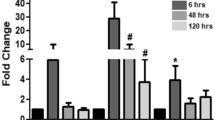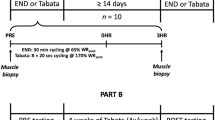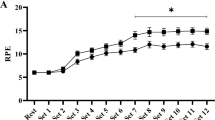Abstract
Evidence indicates that repeated-bouts of eccentric exercise (EE) do not exacerbate the extent of muscle damage indices, as compared to a single-bout. We hypothesized that molecular adaptations, under repeated-bouts of EE, would include suppression of muscle repair inhibitory factors such as myostatin and up-regulation of muscle repair positive regulatory factors such as myogenic regulatory factors (MRFs). Fifteen males were recruited for this study. The exercise group (n = 9) successfully completed six sets of 15 reps of maximum voluntary eccentric contractions, for six consecutive days, using a dynamometer (Multicont-II). Blood and muscle biopsy samples were obtained from each subject 1 week prior to exercise, 2 days post the first training session, and 24 h after the last training session. Gene expression levels were determined using real-time RT-PCR. Blood samples were analyzed for creatine kinase (CK) and lactate-dehydrogenase (LDH) activity. Repeated-bouts of EE induced a large down-regulation of myostatin mRNA (−73%) which persisted throughout the study. The responses of MRFs were mild. At day 3 only myogenin increased significantly (1.9 fold) while MyoD decreased by 45%. Surprisingly, at day 7, despite the presence of muscle damage indices, all MRFs returned to the pre-exercise levels. The results of the present study showed that repeated-bouts of EE, for six consecutive days, dramatically decreased Myostatin mRNA expression but impaired the expression patterns of MRFs such that, with the exception of myogenin that showed a moderate non-sustained increase, MyoD and MYf5 response was minimal.






Similar content being viewed by others
References
Armand Anne-Sophie, Launay T, Gaspera BD, Charbonnier F, Gallien CL, Chanoine C (2003) Effects of eccentric treadmill running on mouse soleus: degeneration/regeneration studied with Myf-5 and MyoD probes. Acta Physiol Scand 179:75–84
Bickel CS, Slade JM, Haddad F, Adams GR, Dudley GA (2003) Acute molecular responses of skeletal muscle to resistance exercise in able-bodied and spinal cord-injured subjects. J Appl Physiol 94:2255–2262
Bickel CS, Slade JM, Mahoney ED, Haddad F, Dudley GA, Adams GR (2005) Time course of molecular responses of human skeletal muscle to acute bouts of resistance exercise. J Appl Physiol 98:482–488
Bogdanovich S, Perkins KJ, Krag TOB, Whittemore LA, Khurana TS (2005) Myostatin propeptide-mediated amelioration of dystrophic pathophysiology. FASEB J 6:543–549
Bullough WS (1965) Mitotic and functional homeostasis: a speculative review. Cancer Res 25:1683–1727
Charge SBP, Rudnicki MA (2004) Cellular and molecular regulation of muscle regeneration. Physiol Rev 84:209–238
Chen TC (2003) Effects of a second bout of maximal eccentric exercise on muscle damage and electromyographic activity. Eur J Appl Physiol 89:115–121
Chen TC, Hsieh SS (2001) Effects of a 7-day eccentric training period on muscle damage and inflammation. Med Sci Sports Exerc 33(10):1732–1738
Dominique JE, Gerard C (2006) Myostatin regulation of muscle development: Molecular basis, natural mutations, physiopathological aspects. Exp Cell Res 312:2401–2414
Endl E, Gerdes J (2000) The Ki-67 protein: fascinating forms and an unknown function. Exp Cell Res 257:231–237
Endl E, Steinbach P, Knuchel R, Hofstadter F (1997) Analysis of cell cycle-related Ki-67 and p120 expression by flow cytometry BrdUrd-Hoechst/7AAD and immunolabeling technique. Cytometry 29:233–241
Haddad F, Adams G (2002) Selected contribution: acute cellular and molecular responses to resistance exercise. J Appl Physiol 93:394–403
Hameed M, Orrell RW, Cobbold M, Goldspink G, Harridge SDR (2003) Expression of IGF-I splice variants in young and old human skeletal muscle after high resistance exercise. J Physiol 574:247–254
Hill J, Davies L, Pearson A (2002) The myostatin propeptide and follistatin-related gene are inhibitory binding proteins of myostatin in normal serum. J Biol Chem 277:40735–40741
Jamurtas AZ, Theocharis V, Tofas T, Tsiokanos A, Yfani C, Paschalis V, Koutedakis Y, Nosaka K (2005) Comparison between leg and arm eccentric exercises of the same relative intensity on indices of muscle damage. Eur J Appl Physiol 95:179–185
Joulia D, Bernardi H, Garandel V, Rabenoelina F, Vernus B, Cabello G (2003) Mechanisms involved in the inhibition of myoblast proliferation and differentiation by myostatin. Exp Cell Res 286:263–275
Kim J, Cross JM, Bamman MM (2005) Impact of resistance loading on myostatin expression and cell cycle regulation in young and older men and women. Am J Physiol Endocrinol Metab 288:1110–1119
Langley B, Thomas M, Bishop A, Sharma M, Gilmours S, Kambadur R (2002) Myostatin inhibits myoblast differentiation by down-regulating MyoD expression. The J Biol Chem 277:49831–49840
Launay T, Armand A-S, Charbonnier F, Mira Jean-Claude, Donsez E, Gallien CL, Chanoine C (2001) Expression and neural control of myogenic regulatory factor genes during regeneration of mouse soleus. J Histochem Cytochem 49:887–899
Li H, Capetanaki Y (1993) Regulation of the mouse desmin gene: transactivation by MyoD, myogenin, MRF4, and Myf5. Nucleic Acid Res 21:335–343
Lin H, Yutzey KE, Konieczny SF (1991) Muscle-specific expression of the troponin I gene requires interactions between helix-loop-helix muscle regulatory factors and ubiquitous transcription factors. Mol Cell Biol 11:267–280
Mahoney DJ, Garey K, Fu MH, Snow R, Cameron SD, Parise G, Tarnopolsky MA (2004) Real-time RT-PCR analysis of housekeeping genes in human skeletal muscle following acute exercise. Physiol Genomics 18:226–231
Mauro A (1961) Satellite cell of skeletal muscle fibers. J Biophys Biochem Cytol 9:493–495
McCroskery S, Thomas M, Maxwell L, Sharma M, Kambadur R (2003) Myostatin negatively regulates satellite cell activation and self-renewal. J Cell Biol 162:1135–1147
McCroskery S, Thomas M, Platt L, Hennebry A, Nishimura T, McLeay L, Sharma M, Kambadur R (2005) Improved muscle healing through enhanced regeneration and reduced fibrosis in myostatin-null mice. J Cell Sci 118:3531–3541
McPherron AC, Lee SJ (1997) Double muscling in cattle due to mutations in the myostatin gene. Proc Natl Acad Sci USA 94:12457–12461
McPherron AC, Lawler AM, Lee SJ (1997) Regulation of skeletal muscle mass in mice by a new TGF-beta superfamily member. Nature 387:83–90
Megeny LA, Rudnicky MA (1995) Determination versus differentiation and the MyoD family of transcription factors. Biochem Cell Biol 73:723–732
Mendler L, Zador E, Dux L, Wuytack F (1998) mRNA levels of myogenic regulatory factors in rat slow and fast muscles regenerating from notexin-induced necrosis. Neuromuscul Disord 8:533–541
Nosaka K, Newton M (2002) Repeated eccentric exercise bouts do not exacerbate muscle damage and repair. J Strength Cond Res 16:117–122
Peters D, Barash IA, Burdi M, Yuan PS, Mathew L, Friden J, Lieber RL (2003) Asynchronous functional, cellular and transcriptional changes after a bout of eccentric exercise in the rat. J Physiol 553:947–957
Proske U, Morgan DL (2001) Muscle damage from eccentric exercise: mechanism, mechanical signs, adaptation and clinical applications. J Physiol 537:333–345
Psilander N, Damsgaard R, Pilegard H (2003) Resistance exercise alters MRF and IGF-I mRNA content in human skeletal muscle. J Appl Physiol 95:1038–1044
Roth SM, Martel GF, Ferell RE, Metter EJ, Hurley BF, Rogers MA (2003) Myostatin gene expression is reduced in humans with heavy-resistance strength training: a brief communication. Exp Biol Med 228:706–709
Scholzen T, Gerdes J (2000) The Ki-67 protein: from the known and the unknown. J Cell Physiol 182:311–322
Shibata M, Matsumoto K, Aikawa K, Muramoto T, Fujimura S, Kadowaki M (2006) Gene expression of myostatin during development and regeneration of skeletal muscle in Japanese Black Cattle. J Anim Sci 84:2983–2989
Wentworth BM, Donoghue M, Engert JC, Berglund EB, Rosenthal N (1991) Paired MyoD-binding sites regulate myosin light chain gene expression. Proc Natl Acad Sci 88:1242–1246
Willoughby DS (2004) Effects of heavy resistance training on myostatin mrna and protein expression. Med Sci Sports Exerc 36:574–582
Yan Z, Choi S, Liu X, Zhang M, Schageman JJ, Lee YS, Hart R, Ling L, Thurmond AF, Williams SR (2003) Highly coordinated gene regulation in mouse skeletal muscle regeneration. J Biol Chem 278:8826–8836
Yang Y, Creer A, Jemiolo B, Trappe S (2005) Time course of myogenic and metabolic gene expression in response to acute exercise in human skeletal muscle. J Appl Physiol 98:1745–1752
Acknowledgments
The authors thank the subjects for their participation and willingness to provide multiple muscle biopsy samples. We also acknowledge Dr. Bird Taylor for reviewing the manuscript.
Author information
Authors and Affiliations
Corresponding author
Additional information
Grants: Funding was provided by the Ministry of Health of the Hungarian Government. Grant number: ETT 388/2003.
Rights and permissions
About this article
Cite this article
Costa, A., Dalloul, H., Hegyesi, H. et al. Impact of repeated bouts of eccentric exercise on myogenic gene expression. Eur J Appl Physiol 101, 427–436 (2007). https://doi.org/10.1007/s00421-007-0510-z
Accepted:
Published:
Issue Date:
DOI: https://doi.org/10.1007/s00421-007-0510-z




